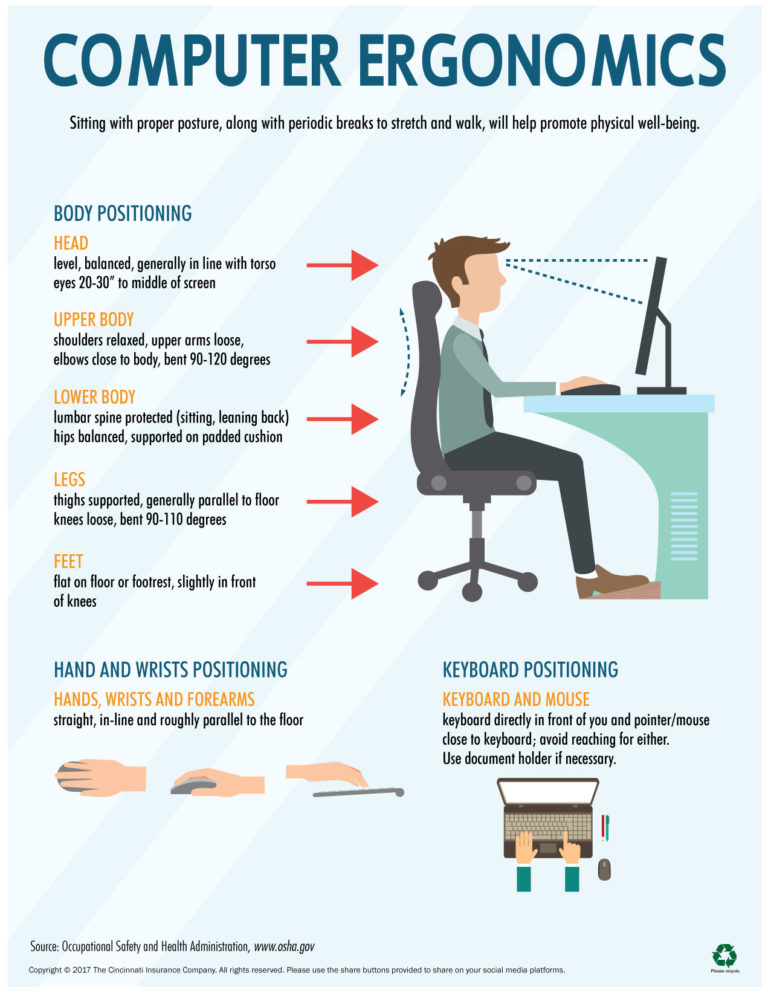

Conclusion: The study revealed the lack of knowledge about the ergonomic practices.
Health and safety using computers at work free#
Dispro-portion was observed between the knowledge and practices of correct viewing distance from the computer screen, maintaining print at eye level, keeping computer screen free of glare and moving the chair for better keyboard use. Postures used by laptop users and desktop users vary according to the location-home, college, hostel. Of the total respondents, 75% said that they aren't aware of 'ergonomics' term and 68% (17 out of 25) reported that they never had any ergonomic survey up till. Results: The sample size consisted of 100 students, of which 58 males and 42 females entered their responses.

SPSS version 24.0 was used to analyze the captured responses. Method: An observational cross-sectional study was conducted through a questionnaire that consisted of questions related to the ergonomics knowledge and its practices, visual complaints, work posture, etc.

The learning environment of a computer science student is a computer-networked classroom, labs, and working area, that on an average, a student spends 6-8 hours staring at a screen daily. Objective: The objective of this study was to assess the ergonomics of final year undergraduate and postgraduate computer science students at Department of Computer Science, Aligarh Muslim University, India, with the aim of creating awareness of ergonomics and its application among these students. Conclusion: The study revealed lack of information and skills in ergonomics contributing to poor ergonomic conditions and consequent visual discomforts among computer users in the work place. Neck, back and shoulder pains were reported by 85% of respondents while 73% complained of eyestrain. Most (70%) of the workers acknowledged not having knowledge of ergonomics whiles 100% noted that they did not have any ergonomic assessment of their workstations.
Health and safety using computers at work windows#
Results: Almost half (50%) of respondents had monitors facing windows without appropriate blinds, 42% with monitor tilt angle less than 10 degrees and majority (76%) observed monitors either at or above horizontal eye level. Descriptive statistics using Statistical Package for Social Sciences (SPSS) Version 20.0 was used for data analysis. This cross-sectional study consisted of a checklist (computer workstation components, visual complaints and ergonomics knowledge), work posture observations and measurements of workstation linear distances and monitor tilt angle. Respondents selected included secretaries, research assistants and data and account processors. Method: A total of 150 office employees purposively sampled participated in this study. The study therefore sought to assess computer workstation designs in administrative offices at Kwame Nkrumah University of Science and Technology, with the aim of creating awareness of ergonomics and its application among administrative office computer users. Injuries and discomforts therefore have higher propensity to occur since most offices formally designed for paper-based work now accommodate computer workstations, without corresponding redesigning. Tremendous usage of computers in most offices of emerging economies have however, not seen accompanying applications of ergonomics in the design of computer workstations despite the numerous benefits. Objective: Ergonomically designed workstations have direct bearing on the comfort and safety of office computer users.


 0 kommentar(er)
0 kommentar(er)
